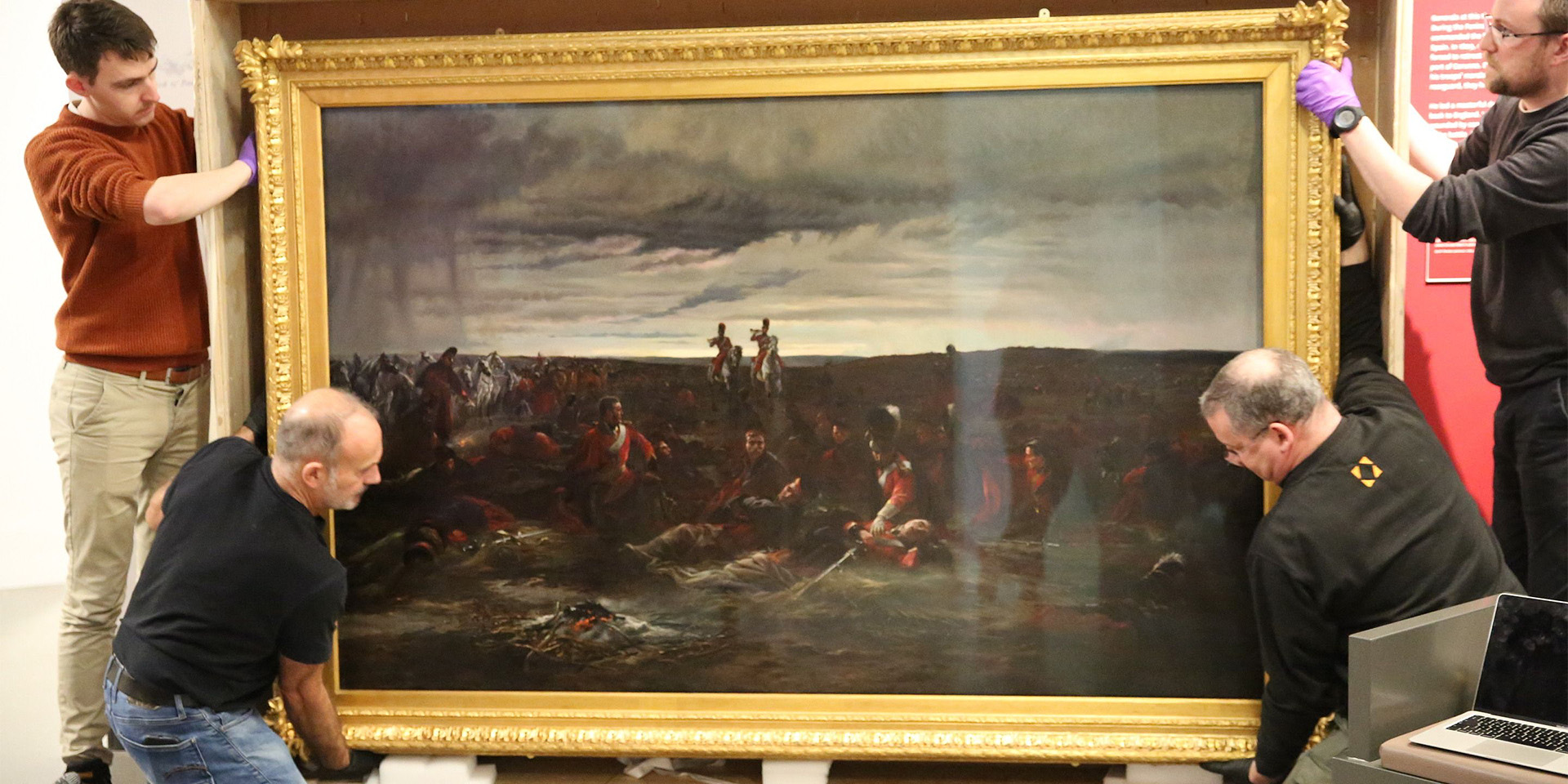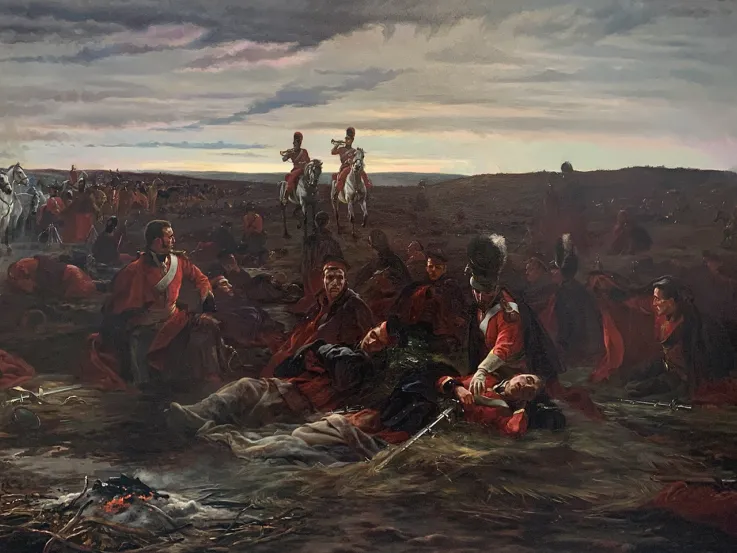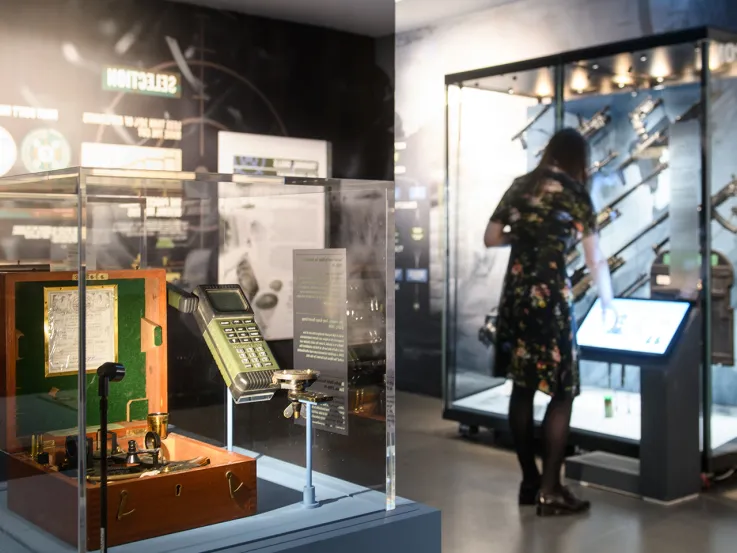Restored Waterloo painting now on display at the National Army Museum

Friday, 16 June 2023
A rediscovered British masterpiece, ‘Dawn of Waterloo’, is now on public display for the first time in a generation. Created in 1895 by the pioneering female artist Lady Butler, the painting depicts a key moment before the pivotal Battle of Waterloo on 18 June 1815.
The work was acquired by the National Army Museum via auction at Bonhams in 2021, with the generous support of Art Fund.
Work carried out by Lincoln Conservation, based at the University of Lincoln, revealed hidden details that had disappeared under 120 years of historic varnish, including dramatic rainclouds which soaked the Napoleonic battlefield. Unlike other military painters of the time, Lady Butler focused on ordinary soldiers, giving viewers a unique human perspective.
Ian Maine, Assistant Director Collections and Programmes at the National Army Museum, said:
'Elizabeth Butler is a highly regarded Victorian artist, whose work is something the National Army Museum is always very keen to acquire. Her works tell their stories very vividly, as well as much about the world in which they were created.'
‘Dawn of Waterloo’ - also known as ‘The "Reveille" in the Bivouac of the Scots Greys on the Morning of the Battle, 1815’ - depicts a key moment before battle as the trumpeters sound the reveille (a wake-up call). Painted some 80 years after the event, it reflects Victorian society’s obsession with Britain’s military past.
Susan Ward, Head of Art at the National Army Museum, highlighted some the intricacies and nuances of the painting:
'One of the things that was highlighted to me when I joined the Museum was this acquisition made in late 2021 and that was "Dawn of Waterloo". Butler’s painting is a key work in that it changed the public's perception and advocacy of war in Victorian Britain. People began to think differently about soldiers and what it was actually like for them.
'When she was painting "Dawn of Waterloo", Lady Butler was committed to making things accurate. She went to markets and antique shops and purchased uniforms, helmets and weaponry from the time of the battle. She purchased a rye field and had a local regiment of soldiers come and trample on the ground and lie in various positions to recreate the scene as truly as possible.'
Elizabeth Thompson, later Lady Butler, was not from a military family and had few connections with the Army. She began receiving an education in art while living in Italy with her family. After moving to England in 1866, she began studying at the Female School of Art in South Kensington, which was where she began exhibiting her artwork. The National Army Museum holds around 800 individual drawings and sketches by Lady Butler in its collection.
The ‘Dawn of Waterloo’ went through expert conservation work to prepare for its first display in a generation. Work began in November 2022 by conservators at Lincoln Conservation, University of Lincoln and took around four months to complete. Over 120 years of yellowed varnish was removed, cracks in the paint were repaired and the canvas was relined to correct deformations from a defective previous wax lining.
The biggest change to the work is the sky, which prior to conservation, looked very much like a sunset, rather than a sunrise, or ‘dawn’. Lady Butler painted the ‘Dawn of Waterloo’ entirely outdoors, so that she could accurately capture the different hues of the sky at dawn. The skyscape of the painting is therefore an integral part of the subject, and not just added as a backdrop.
The conservation work revealed several elements that show Lady Butler’s desire to accurately depict the subject. Most noticeably, a storm in the top left corner was fully revealed. It was well documented that heavy rain befell the battlefield the night before.
Rhiannon Clarricoates ACR, Senior Research Fellow and Lead Conservator at Lincoln Conservation, said of the conservation process:
'It was an honour to work on such a high-calibre painting, which is undoubtedly one of the most beautiful we’ve had the privilege of conserving.
'The most satisfying element was varnish removal, which revealed numerous minute details that were previously obscured by the heavily discoloured and oxidised varnish. One of our conservators, a horsewoman in her spare time, commented on the anatomical accuracy of the horses and the highly individual characteristics portrayed. Furthermore, as well as revealing the colours of the dawn light, removal of the yellowed varnish restored the illusion of depth in the painting.
'Another key component was the re-framing. As the painting only had a narrow slip frame, we sourced, gilded and toned a suitable reproduction frame, which also enabled conservation framing with museum glass. The new frame elevates the painting, giving it much more presence, without detracting from the complex and personal scene depicted.'
‘Dawn of Waterloo’ will also feature in a major new exhibition at the National Army Museum in 2025 on Victorian art. This exhibition will include key artworks and objects from the Museum’s collection, highlighting military art from 1820 to 1914. The display will highlight the shift in public perception of soldiers after the Napoleonic Wars and a number of Army reforms, including the introduction of the Victoria Cross. It will also showcase Lady Butler’s sketches and her enduring legacy and pioneering approach to war art.
Other notable paintings by Lady Butler include:
- ‘Calling the Roll After An Engagement, Crimea’ (or ‘The Roll Call’) painted in 1874, and ‘The Defence of Rorke's Drift’ painted in 1880 – both in the Royal Collection.
- ‘The Remnants of an Army’ painted in 1879 – on display at Tate Britain
- ‘In the Retreat from Mons: The Royal Horse Guards’, painted in 1927 – displayed at the Royal Hospital Chelsea
Jenny Waldman, Director of Art Fund, said:
'The "Dawn of Waterloo" by Lady Butler is a remarkable painting with a fascinating history. I’m so pleased Art Fund has been able to support the National Army Museum to acquire this rare Victorian work for their collection, where it has been put on public display for the first time in a generation.'
‘Dawn of Waterloo’ is now on display in the Museum’s newly opened Conflict in Europe gallery. Visitors can immerse themselves in the Battle of Waterloo from all angles as Marengo, Napoleon’s horse, and William Siborne’s epic model of the battle are also on free display.
Discover more about the work undertaken by Lincoln Conservation in our Dawn of Waterloo website story.
Notes to editors
For more information, please contact the National Army Museum Communications Team at press@nam.ac.uk
About the National Army Museum
The National Army Museum shares the history and heritage of our soldiers and their service in the Army, across the globe and down the centuries. Through our collections we explore the history of the Army from its origins to the present day. We aim to engage and inspire everyone with the stories of our soldiers and how their service shapes our world; past, present and future.
About the Art Fund
Art Fund is the national fundraising charity for art. It provides millions of pounds every year to help museums to acquire and share works of art across the UK, further the professional development of their curators, and inspire more people to visit and enjoy their public programmes. Art Fund is independently funded, supported by Art Partners, donors, trusts and foundations and the 135,000 members who buy the National Art Pass, who enjoy free or discounted entry to over 850 museums, galleries and historic places, 50% off major exhibitions, and receive Art Quarterly magazine. Art Fund also supports museums through its annual prize, Art Fund Museum of the Year. The winner of Art Fund Museum of the Year 2022 is Horniman Museum & Gardens. www.artfund.org
About Lincoln Conservation
Lincoln Conservation, based at the University of Lincoln, undertakes conservation and research work for clients. We are specialists in the conservation and restoration of decorative interiors, easel paintings, artefacts, historic paint analysis and digital heritage. We combine scientific analysis and archive research with an understanding of materials and techniques to inform the conservation or reinstatement programme. www.lincolnconservation.co.uk



